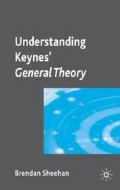Abstract
In the General Theory Keynes finally breaks with Say’s law.1 In its place he outlines a theory of what determines aggregate income, output and employment in which the central unifying concept of aggregate effective demand plays the leading role. Effective demand is the single most important idea in Keynes’ General Theory model. It is essential that the reader has a proper appreciation of this category of analysis.2
Access this chapter
Tax calculation will be finalised at checkout
Purchases are for personal use only
Preview
Unable to display preview. Download preview PDF.
Author information
Authors and Affiliations
Copyright information
© 2009 Brendan Sheehan
About this chapter
Cite this chapter
Sheehan, B. (2009). Aggregate Effective Demand. In: Understanding Keynes’ General Theory. Palgrave Macmillan, London. https://doi.org/10.1057/9780230232853_3
Download citation
DOI: https://doi.org/10.1057/9780230232853_3
Publisher Name: Palgrave Macmillan, London
Print ISBN: 978-1-349-30565-0
Online ISBN: 978-0-230-23285-3
eBook Packages: Palgrave Economics & Finance CollectionEconomics and Finance (R0)

